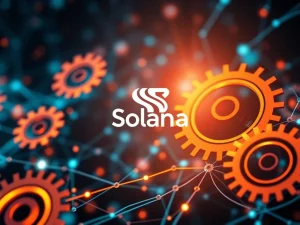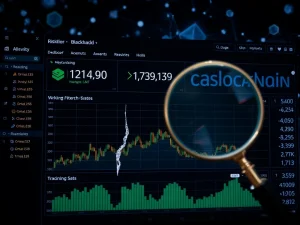Explosive Growth: Tokenized Alternative Funds Surge 47% to $1.7 Billion

The digital asset landscape constantly evolves. Currently, a significant trend is captivating financial markets: the remarkable ascent of tokenized alternative funds. These innovative investment vehicles have recently experienced an explosive surge, reflecting a growing appetite among sophisticated investors for blockchain-powered solutions. In just 30 days, the total value of these funds jumped an impressive 47%, reaching a staggering $1.74 billion. This rapid expansion highlights the transformative potential of RWA tokenization and its ability to bridge traditional finance with the efficiency of blockchain technology.
Understanding Tokenized Alternative Funds and Their Appeal
What exactly are tokenized alternative funds? These are professionally managed investment vehicles that allocate capital into non-traditional asset classes. Historically, these funds include hedge funds, private equity, private credit, venture capital, real estate, and infrastructure. They stand apart from conventional stocks and bonds. Tokenization brings these assets onto a blockchain, transforming them into digital tokens. This process unlocks several crucial benefits for institutional investors.
Key advantages of tokenizing alternative funds include:
- Faster Settlement: Blockchain transactions execute much quicker than traditional processes.
- Wider Investor Access: Tokenization can fractionalize ownership, potentially lowering entry barriers.
- Greater Transparency: Immutable blockchain records offer enhanced visibility and auditability.
- Increased Liquidity: Digital tokens can be traded more easily on secondary markets.
This integration of alternative assets with blockchain technology signals a powerful shift. Consequently, traditional financial institutions are showing increased demand for RWA tokenization, seeking to leverage these efficiencies.
The Unstoppable Rise: Market Dynamics and Key Players
Recent data from RWA.xyz, a leading real-world asset (RWA) tokenization tracker, confirms this upward trajectory. All major protocols, with the sole exception of Libre Capital, recorded significant percentage increases over the last month. This widespread growth indicates robust market health and confidence. Notably, Centrifuge has emerged as a dominant force within this burgeoning sector.
Centrifuge protocol experienced a remarkable 252% expansion in its market cap. It now commands $704 million, securing a substantial 40.4% market share for institutional alternative funds (IAFs). Furthermore, Centrifuge also manages nearly $400 million in tokenized US Treasury products. This combined effort pushed its total value locked (TVL) past the $1 billion mark. This achievement places Centrifuge alongside prominent players like BlackRock’s BUIDL fund and Ondo Finance in surpassing the significant $1 billion RWA milestone.
Following Centrifuge, Securitize holds a strong position. It manages $652 million across 14 tokenized IAFs, accounting for 37.5% of the market. Other notable protocols contributing to the market’s expansion include Superstate with $206 million and OnRe with $102 million in fund value. These figures clearly illustrate the concentrated growth among a few key innovators.
Ethereum Blockchain Maintains Dominance in Tokenization
The choice of underlying blockchain network is crucial for the success of tokenized assets. The Ethereum blockchain continues to assert its unparalleled dominance in this domain. According to RWA.xyz data, Ethereum hosts an impressive $1 billion in total value for tokenized IAFs. This figure represents more than half of the entire market. Its robust infrastructure, established developer community, and battle-tested security make it a preferred platform for issuing and managing high-value institutional assets. Consequently, institutions often favor Ethereum for its reliability and widespread adoption.
While Ethereum leads, other networks are also gaining traction. Mantle and ZKsync Era follow with $218.8 million and $214.8 million, respectively. Solana accounts for $135.2 million. Smaller, yet growing, amounts are observed on networks like Plume ($59.2 million) and Avalanche ($41.2 million). This multi-chain landscape suggests increasing diversification but firmly entrenches Ethereum as the primary hub for significant institutional capital in RWA tokenization.
Shifting Dynamics: Holders Increase, Active Addresses Decline
An interesting paradox emerges from the recent data: while the value of tokenized alternative funds soared, monthly active addresses dropped by over 50% to 21,867 in the last 30 days. Simultaneously, the number of holders increased by 13.5% to 114,922. This divergence offers valuable insights into market behavior, particularly concerning institutional investors.
This trend strongly suggests that institutions or professional investors are consolidating their funds into fewer addresses. Such consolidation is a common practice among large entities for operational efficiency and security. Furthermore, the increase in the number of holders, despite fewer active addresses, implies that new investors are buying and holding these tokens for the long term. This signals strong, enduring confidence in tokenized alternative funds as a viable investment vehicle. It underscores a maturation of the market, moving beyond speculative trading towards strategic, long-term asset allocation.
The Broader Impact of RWA Tokenization on Finance
The growth of tokenized alternative funds is not an isolated event. Instead, it forms a crucial part of the broader RWA tokenization movement. This paradigm shift involves bringing various real-world assets onto the blockchain. These include not only private credit and equity but also tangible assets like real estate, art, and commodities. The underlying principle remains consistent: leveraging blockchain’s inherent advantages to enhance liquidity, transparency, and accessibility for assets traditionally confined to illiquid, opaque markets.
The increasing participation of institutional investors further validates this trend. Their involvement brings significant capital, expertise, and credibility to the crypto space. As regulatory frameworks evolve and technology matures, the integration of traditional financial products with blockchain infrastructure will likely accelerate. This convergence promises to redefine capital markets, making them more efficient and globally accessible. The success of protocols like Centrifuge on the Ethereum blockchain serves as a compelling case study for this future.
Future Outlook for Tokenized Alternative Funds
The current momentum for tokenized alternative funds suggests a bright future. As more institutions recognize the benefits of blockchain technology, we can anticipate continued growth. However, challenges remain, including regulatory clarity and the need for robust infrastructure. Despite these hurdles, the trajectory is clear: tokenization is set to become a fundamental component of modern finance.
The ability to fractionalize ownership, automate processes with smart contracts, and provide near-instant settlement offers undeniable advantages. This innovation will attract an even wider range of investors. Consequently, the market for real-world asset tokenization will likely expand beyond its current scope. This evolution promises a more interconnected and efficient global financial system, with tokenized alternative funds at its forefront.








